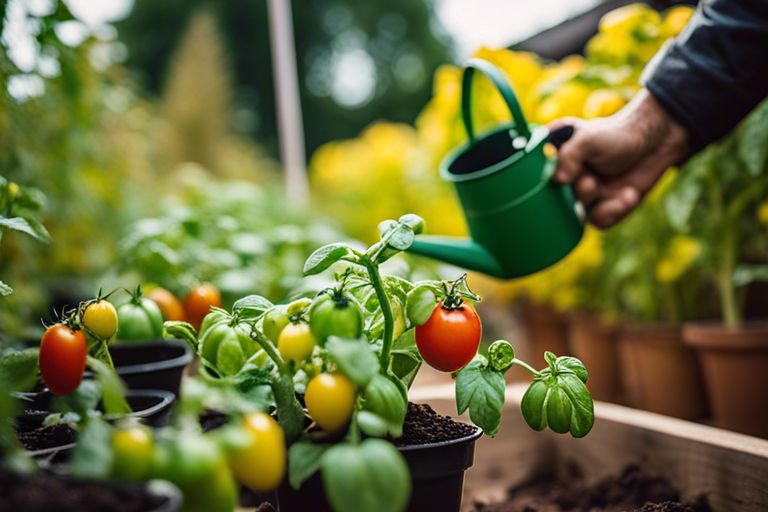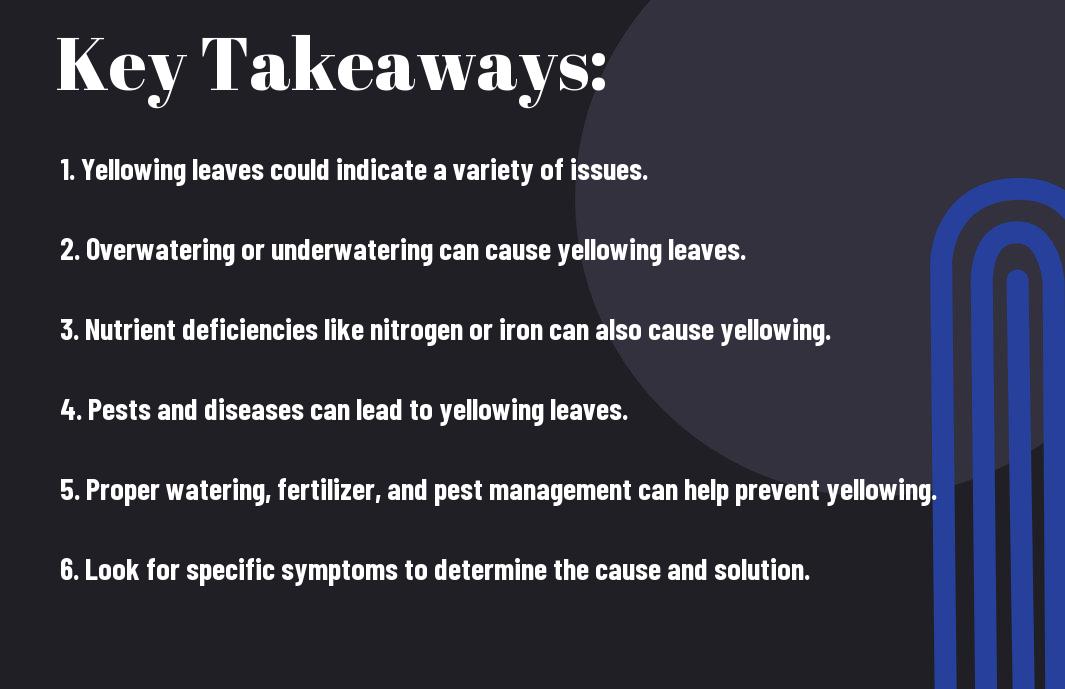Experiencing yellowing leaves on your tomato plant can be concerning, as it may indicate a potential problem with the plant’s health. There are several factors that can lead to yellow leaves on a tomato plant, including nutrient deficiencies, pests, diseases, and environmental stressors. In order to address this issue and restore your tomato plant to good health, it’s important to accurately diagnose the cause of the yellowing leaves and take appropriate action. In this blog post, I will explore the common causes of yellowing leaves on tomato plants and provide effective solutions to remedy the problem.
Key Takeaways:
- Overwatering can cause yellowing of tomato plant leaves. Ensure proper drainage and only water when the top inch of soil is dry.
- Nutrient deficiencies such as lack of nitrogen, magnesium, or iron can lead to yellow leaves. Use an appropriate fertilizer according to the plant’s needs.
- Plant diseases like fusarium wilt or bacterial canker can manifest as yellow leaves. Proper sanitation and use of disease-resistant varieties can help prevent these issues.
- Pests such as aphids or spider mites can cause yellowing leaves. Regular inspection and use of organic pest control methods can mitigate this problem.
- Proper maintenance practices, including regular pruning, proper spacing, and adequate sunlight, can help maintain healthy tomato plants and prevent yellowing leaves.
Common Causes of Yellowing Leaves on Tomato Plants
For a comprehensive list of common causes of yellowing leaves on tomato plants, you can refer to this article on Better Homes & Gardens titled “Got Yellow Leaves on Tomato Plants? 9 Reasons Why and …”
Nutrient Deficiency
One common cause of yellowing leaves on tomato plants is nutrient deficiency, particularly nitrogen. When your tomato plants lack the necessary nutrients, their leaves may start to turn yellow. To remedy this, I recommend using a balanced fertilizer that is specifically formulated for tomatoes. Ensure that you follow the application instructions to avoid over-fertilization, which can also lead to yellowing leaves.
Overwatering
If you notice yellowing leaves on your tomato plants, overwatering might be the culprit. Overwatering can lead to root rot, preventing the roots from absorbing nutrients properly. To fix this issue, make sure to adjust your watering schedule and allow the soil to dry out between watering sessions. You can also consider improving drainage in the soil to prevent waterlogging.
Underwatering
On the other hand, underwatering can also result in yellowing leaves on tomato plants. When the plants don’t receive enough water, they struggle to carry out essential physiological functions, leading to yellowing and wilting. To address this, I recommend creating a regular watering schedule and ensuring that your tomato plants receive an adequate amount of water, especially during hot weather.
Pest Infestation
Pest infestations, such as whiteflies, aphids, or spider mites, can cause damage to tomato plants, resulting in yellowing leaves. These pests feed on the plant’s nutrients, weakening the plant and causing discoloration. To mitigate the impact of pest infestations, I suggest regularly inspecting your plants for signs of pests and applying organic insecticidal soap or neem oil to control the infestation.
Disease
Diseases such as early blight, fusarium wilt, or bacterial canker can cause yellowing leaves on tomato plants, often accompanied by other symptoms such as wilting, spotting, or stunted growth. To prevent the spread of diseases, I advise planting disease-resistant varieties, practicing crop rotation, and ensuring good airflow around the plants to reduce humidity and minimize the risk of fungal diseases.
How to Fix Yellowing Leaves on Tomato Plants
Despite your best efforts to prevent yellowing leaves on your tomato plants, sometimes it happens. The good news is that there are several steps you can take to fix the issue and get your plants back to their full health.
Soil Testing and Fertilization
One of the first things I recommend doing is testing your soil to determine if it lacks any essential nutrients. You can purchase a soil testing kit from your local garden center or hire a professional to do it for you. Based on the results, you can then fertilize your soil with the necessary nutrients to address any deficiencies. Over-fertilization can also cause yellowing of leaves, so be sure to follow the recommended application rates.
Proper Watering Techniques
When it comes to watering your tomato plants, it’s crucial to find the right balance. Watering too much or too little can both lead to yellowing leaves. I recommend using a soaker hose or drip irrigation system to deliver water directly to the roots and avoid wetting the foliage. This can help prevent issues such as fungal diseases that can contribute to yellowing leaves.
Pest Control Measures
If you notice yellowing leaves on your tomato plants, it’s essential to inspect them for any signs of pest infestations. Common pests that can cause damage and yellowing leaves include aphids, whiteflies, and spider mites. If you identify any pests, you can use natural remedies such as insecticidal soap or neem oil to control the infestation and prevent further damage.
Disease Management
In addition to pests, diseases such as early blight, late blight, and fusarium wilt can also cause yellowing of tomato plant leaves. I recommend removing and destroying any affected leaves to prevent the spread of the disease. It’s also essential to practice crop rotation and proper sanitation to prevent the recurrence of these diseases in your garden.
Preventing Yellowing Leaves on Tomato Plants
Your tomato plants can stay healthy and vibrant by taking proactive measures to prevent yellowing leaves. Start by regularly monitoring your plants for any signs of distress or nutrient deficiencies. You can also refer to this helpful resource on 8 Reasons Your Tomato Leaves Are Turning Yellow (and … for more in-depth information on the subject.
Proper Plant Nutrition
Ensuring that your tomato plants receive the proper nutrients is essential for preventing yellowing leaves. I highly recommend using a balanced fertilizer specifically formulated for tomatoes to promote healthy foliage and overall plant growth. Be sure to follow the recommended application rates, as over-fertilizing can also lead to leaf discoloration. Additionally, consider adding compost or organic matter to the soil to improve its texture and nutrient content.
Regular Monitoring and Maintenance
Regularly monitoring your tomato plants for any signs of stress or disease is crucial for preventing yellowing leaves. I recommend checking the leaves, stems, and fruit for any discoloration, spots, or abnormalities. Early detection of issues allows for prompt intervention, which can prevent further damage to the plant. Additionally, proper maintenance practices, such as pruning, staking, and providing adequate support, can help promote optimal plant health and reduce the risk of leaf yellowing.
Companion Planting
Companion planting is another effective strategy for preventing yellowing leaves on tomato plants. Consider planting companion herbs and flowers, such as basil, marigolds, or parsley, near your tomatoes. These companion plants can help repel pests, attract beneficial insects, and improve soil health, creating a more favorable growing environment for your tomato plants. Additionally, diverse plantings can contribute to a more balanced ecosystem and reduce the risk of disease and nutrient imbalances.


Yellowing Leaves on a Tomato Plant – What Causes It and How to Fix?
Following this guide, you should now have a better understanding of why your tomato plant’s leaves may be yellowing and how to remedy the issue. It’s important to pay close attention to the overall health and care of your plants, including proper watering, fertilization, and pest management. Remember to regularly check for signs of nutrient deficiencies, disease, or pests and take proactive measures to address any issues that arise. By staying vigilant and providing attentive care, you can help ensure the health and productivity of your tomato plants for a bountiful harvest.
FAQ
Q: What causes yellowing leaves on a tomato plant?
A: Yellowing leaves on a tomato plant can be caused by a variety of factors, including nutrient deficiencies, watering issues, diseases, pests, and environmental stress.
Q: What are the common nutrient deficiencies that cause yellowing leaves on tomato plants?
A: Common nutrient deficiencies that cause yellowing leaves on tomato plants include nitrogen, magnesium, potassium, and iron deficiencies.
Q: How can I fix yellowing leaves on my tomato plant due to nutrient deficiencies?
A: To fix yellowing leaves on a tomato plant due to nutrient deficiencies, you can apply a balanced fertilizer, such as a 10-10-10 fertilizer, to provide the necessary nutrients. You can also use specific nutrient supplements, such as Epsom salt for magnesium deficiency, to address the issue.
Q: How do I prevent diseases and pests from causing yellowing leaves on my tomato plant?
A: Prevent diseases and pests from causing yellowing leaves on your tomato plant by practicing good garden hygiene, such as removing and disposing of infected plant material, using disease-resistant tomato varieties, and regularly inspecting your plants for signs of pests and diseases.
Q: What environmental factors can cause yellowing leaves on tomato plants and how can I mitigate them?
A: Environmental factors such as overwatering, underwatering, excessive heat, and poor soil drainage can cause yellowing leaves on tomato plants. To mitigate these factors, ensure that your tomato plants are watered consistently, provide shade during extreme heat, and improve soil drainage by amending the soil with organic matter.









Leave a comment